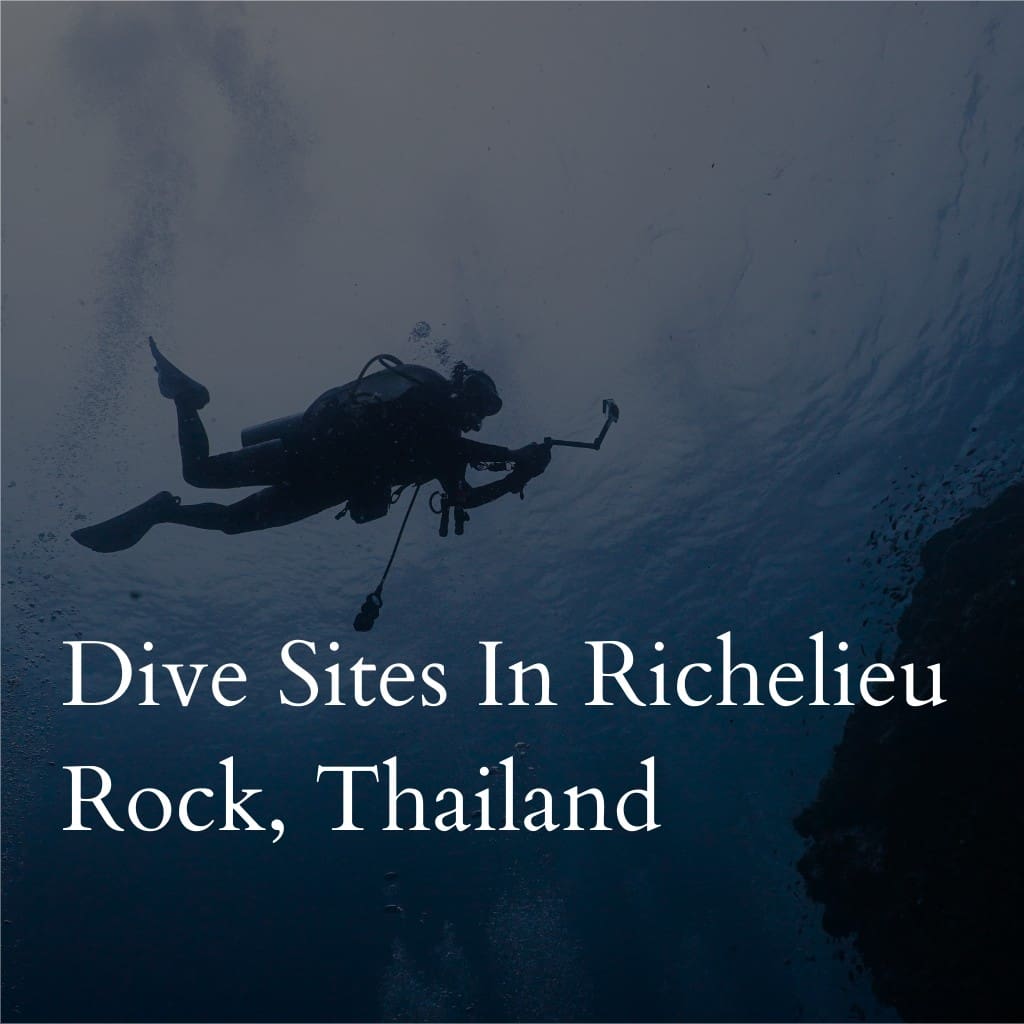Richelieu Rock is distinguished by its unique structure—an isolated pinnacle that emerges from the depths to just below the surface at low tide. This geological feature serves as a magnet for pelagic species and an array of macro life, making it a must-visit for both wide-angle and macro photographers. The convergence of nutrient-rich currents around the pinnacle fosters an incredibly dynamic underwater ecosystem, teeming with marine life all year round.
In this article, we’ll delve deep into the allure of Richelieu Rock, covering:
- An exploration of the diverse dive sites and their unique characteristics.
- An overview of the marine species that make Richelieu Rock their home.
- Details on special encounters with rare and charismatic marine creatures.
- Photography tips for capturing the stunning underwater landscapes.
- Specifics on site suitability for divers of different experience levels.
- Practical considerations, including water conditions, visibility, and safety tips.
Top Dive Sites
The Main Pinnacle
Description: The Main Pinnacle of Richelieu Rock is an underwater haven that rises from the ocean floor to within a few meters of the surface. The pinnacle is enveloped in a mosaic of soft corals and anemones, creating an intricate and colorful seascape. The site’s topography includes ledges, crevices, and small overhangs, which house a variety of marine life.
Marine Species: This site teems with an impressive array of species including barracudas, trevally, and various reef fish. You will encounter vast schools of fusiliers, snappers, and vibrant anemonefish, all calling this rocky paradise home.
Unique Encounters: The Main Pinnacle offers the chance to spot majestic whale sharks, particularly from February to April. Additionally, you may witness cuttlefish during their mating season, as well as large pelagic species such as giant groupers and occasionally manta rays.
Photography: The stunning coral gardens offer perfect backgrounds for both wide-angle and macro photography. The presence of large pelagic species provides exceptional opportunities to capture awe-inspiring underwater scenes.
Suitability: The Main Pinnacle is suitable for divers of all levels, but due to variable currents, it’s recommended that divers have some experience with drift diving. Visibility can be excellent, enhancing the overall experience for everyone.
Eastern Slope
Description: The Eastern Slope of Richelieu Rock features a gradual descent adorned with gorgonian sea fans and whip corals. This area spans depths of 10 to 30 meters, offering a diverse habitat for countless marine species and creating a dynamic and visually rich environment.
Marine Species: Divers can encounter seahorses, ghost pipefish, and frogfish, making it a hotspot for macro enthusiasts. Larger residents include Napoleon wrasses and even the occasional leopard shark.
Unique Encounters: The Eastern Slope is famous for sightings of rare and elusive critters like harlequin shrimps and giant Pacific octopuses. Nudibranch diversity is also high, with numerous colorful species crawling along the coral and sponges.
Photography: Macro photographers will be thrilled with opportunities to capture detailed shots of the unique and colorful small creatures here. The gentle slope also allows for excellent compositional shots with sea fans and whip corals.
Suitability: This site is suitable for intermediate to advanced divers due to the depth and occasional moderate currents. Good buoyancy control is essential to prevent disturbing the delicate marine life.
Southern Reef
Description: The Southern Reef of Richelieu Rock is characterized by impressive hard coral formations and scattered boulders creating natural swim-throughs and hiding spots for marine creatures. Depths here range from 5 to 20 meters, making it accessible and enjoyable for a wide range of divers.
Marine Species: This site is populated with an array of marine animals such as lionfish, scorpionfish, and moray eels. It’s also common to see schools of darting blue chromis and clouds of glassfish.
Unique Encounters: Divers might have the chance to see reef sharks gliding along the sandy patches, as well as titan triggerfish and the fascinating napoleon wrasse. Look out for ornate ghost pipefish camouflaged among the soft corals.
Photography: The coral formations provide beautiful wide-angle shots, while the swim-throughs add an element of adventure. Photographers should be on the lookout for group shots of schooling fish and unique creature portraits.
Suitability: The Southern Reef is ideal for beginners and intermediate divers. The shallow depths and relatively calm conditions make it an excellent site for those looking to increase their experience and confidence underwater.
Considerations for Each Dive Site
Water Temperature: The water temperature at Richelieu Rock typically hovers between 27°C (81°F) and 30°C (86°F) throughout the year, ensuring warm and pleasant diving conditions. A 3mm wetsuit is generally sufficient for most divers, providing enough thermal protection while allowing for flexibility and comfort during dives.
Visibility: Visibility at Richelieu Rock is often between 15 to 30 meters (50 to 100 feet), though it can fluctuate due to factors such as plankton blooms and changing currents. The best visibility is usually encountered during the dry season, from November to April, offering crystal-clear conditions that enhance the vibrant colors and marine life observed during dives.
Currents and Tides: Currents can vary significantly around Richelieu Rock. The Main Pinnacle is known for its variable currents, which can range from mild to strong, providing nutrient-rich waters that attract diverse marine life. The Eastern Slope often has more moderate currents, making it suitable for observing macro life. The Southern Reef generally experiences gentle currents, providing a more relaxed diving environment. It’s essential to be aware of tidal changes and plan dives accordingly to ensure safety and maximize marine life encounters.
Safety Tips:
- Drift Diving: Be prepared for drift diving conditions, especially around the Main Pinnacle. Understand how to use surface markers and maintain close proximity to your dive group.
- Surface Intervals: Schedule adequate surface intervals between dives to ensure safe nitrogen absorption and prevent decompression sickness.
- Monitor Air Supply: Regularly check your air supply and underwater gauges. Be mindful of your air consumption, particularly in deeper sections or areas with strong currents.
- Maintain Buoyancy: Practice precise buoyancy control to avoid damaging delicate coral reefs and to conserve energy while navigating through varying underwater landscapes.
- Emergency Procedures: Familiarize yourself with local emergency procedures and have a plan in place for any unforeseen circumstances.
Regulations: Richelieu Rock falls within the protected waters of the Surin Islands National Park, and divers are expected to adhere to strict conservation guidelines:
- No Touching or Collecting: Avoid touching corals or marine animals and do not collect any marine life, shells, or corals as souvenirs. This helps preserve the site’s natural beauty and ecological balance.
- Use Reef-Safe Products: Use coral-reef-safe sunscreen and personal care products to minimize environmental impact.
- Proper Waste Disposal: Dispose of all waste responsibly and never discard litter into the ocean. This includes plastic waste, food scraps, and other materials.
- Certification Requirements: Ensure you are diving within the limits of your certification and experience level. Certain dive sites, due to currents and depths, are best suited for advanced divers.
- Local Dive Etiquette: Follow local dive etiquette, including respecting the natural habitat of marine species and maintaining a safe distance to avoid disturbing wildlife.
Wrap Up
Diving at Richelieu Rock is a mesmerizing blend of vibrant marine biodiversity and dynamic underwater terrain. Whether you’re captivated by the bustling marine life around the Main Pinnacle, the elusive macro species on the Eastern Slope, or the serene coral formations of the Southern Reef, this dive site offers unparalleled underwater adventures.
With its warm waters, excellent visibility, and rich biological diversity, Richelieu Rock stands as a top-tier diving destination. The consistent influx of nutrient-rich currents not only enhances the marine life but also provides divers with unforgettable encounters, ranging from the smallest critters to majestic whale sharks.
It’s vital to acknowledge the site-specific conditions and adhere strictly to local conservation regulations to help preserve this underwater gem for future generations. So gear up, respect the marine environment, and dive into the dazzling depths of Richelieu Rock for an extraordinary and enriching underwater experience!


Leave a Reply